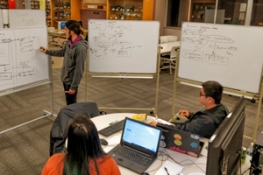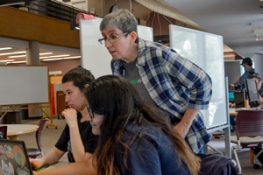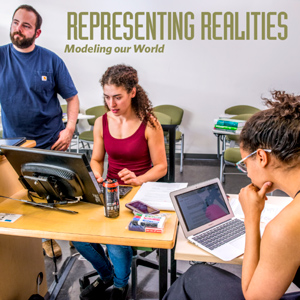Computer Science, B.S.
Computer Science isn’t a discipline you learn by simply reading a textbook. You learn through practical experience–a given at Cal Poly Humboldt.
Why This Program?
Small Class Sizes
Computer science is a crowded field at many universities. But at Cal Poly Humboldt, small class sizes mean you’ll always get the major classes you need.
It also means that you’ll get close attention from your professors in classrooms and labs, and have the opportunity to work on projects with them. Students have collaborated with professors on research into teaching methods, parallel programming, and algorithms.
Our professors provide outstanding advising that helps students stay on track for efficient graduation, and can help motivated students with letters of recommendation and placement in internships.
Hands-on Experience
Hands-on experience is the core of our Computer Science degree. We have a number of facillities and labs that give you a sandbox to experiment with problem solving in multiple programming languages.
You’ll find collaborations are key to computer science - you’ll work with your peers and professors on pair programming, group projects, and events like the annual Hackathon.
Special topics classes touch on a wide array of modern computing: mobile apps, robotics, designing databases and web applications, networking, computer security, parallel programming architecture, algorithms and computing models, operating systems, and more.
Get Hired
Computer science graduates are in high demand. Computer and information technology occupations are projected to grow 12 percent by 2028, adding more than half a million jobs nationwide, according to the Bureau of Labor Statistics.
In 2018 the national median annual wage for computer and information technology occupations was $86,320, significantly higher than the $38,640 for all occupations.
And our graduates go on to tackle the world’s most pressing issues. Humboldt graduates have gone on to PhD programs at Notre Dame University and our alumni include a software engineer for BAE Systems, a DevOps engineer for Amazon Web Services, an operating systems analyst for Humboldt, and a software development engineer for Amazon.
Academics & Options
Our Bachelor of Science degree program focuses on preparing students for roles across the breadth of computer science, in industry, service, and research. Our approach to computer science includes a rigorous and balanced core of mathematical, theoretical and practical knowledge about computation.
Our minor introduces students in other disciplines to key elementary concepts in computing. Though this is not always sufficient for many careers in computing, many Computer Science minors obtain additional training in order to launch careers in the field.
Transfering from a two-year college
Many Computer Science students at Cal Poly Humboldt transfer from a two-year college. We recognize and welcome these students with individually specialized advising for each transfer student. The intensive process helps you graduate efficiently by identifying your experiences and completed coursework and planning the best way to your degree, and career.
Having a mature, career-focused student cohort means we can focus on hands-on experience and preparing you for the job market after graduation.
If you’re motivated and eager to learn, you should be able to complete your bachelor’s degree in Computer Science in 2 years, as long as you’ve completed an Associate Degree for Transfer in Computer Science at your current school.
If you’ve completed sufficient general education requirements, and at least a few introductory programming courses, you should be able to complete your degree in five semesters.
Visit our Admission Transfer Page
Student Learning Outcomes
This degree will teach you:
- Computational thinking, a way of problem solving which draws upon central computing concepts, such as abstraction, virtualization, algorithmic development and analysis, recursion, resource management, and induction.
- Self-directed learning, whereby graduates may maintain their currency in the field by formulating their own learning goals, identifying learning strategies, identifying available resources, implementing learning strategies, and evaluating learning outcomes.
- Communicating and collaborating, which pairs the written and oral skills to deliver information with the ability to respect and embrace the diversity others bring to a team.
- The ability to produce and digest technical documents.








